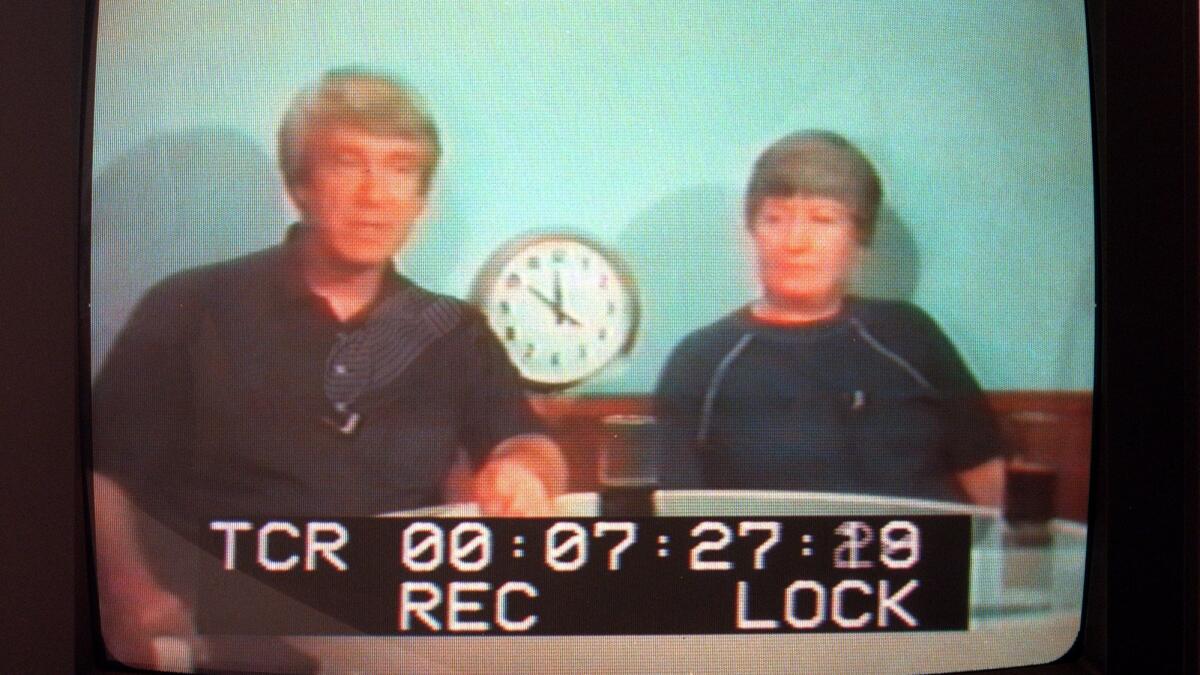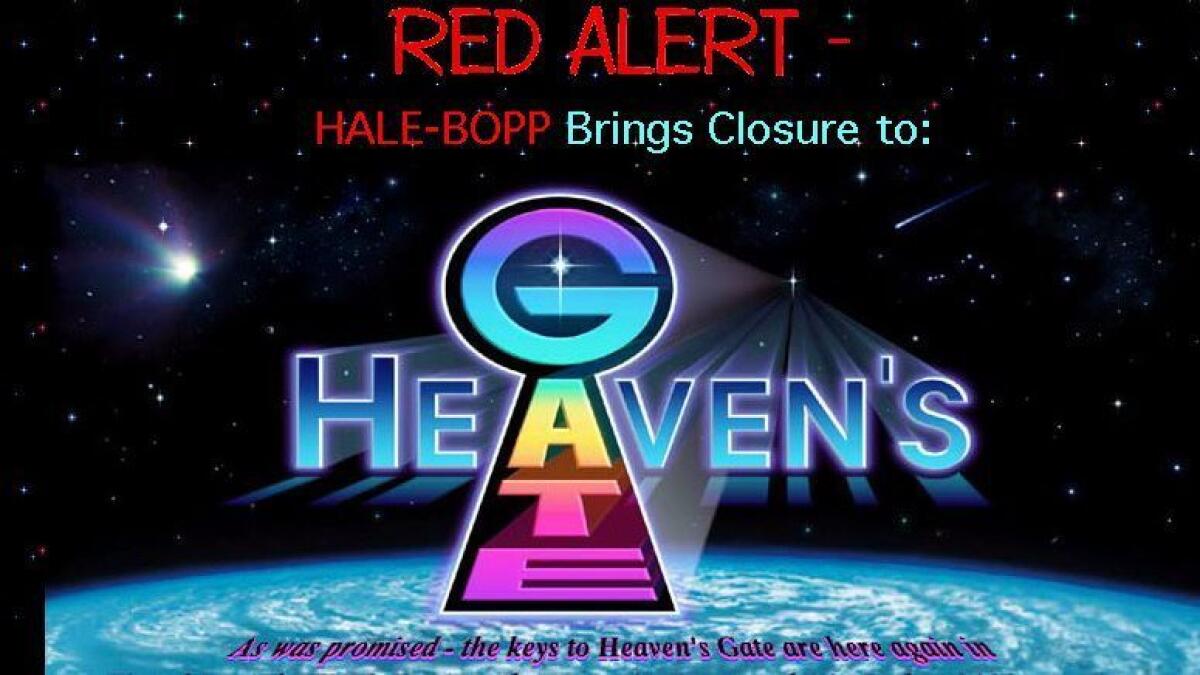Fascination over Heaven’s Gate cult continues, 20 years after mass suicide
- Share via
It happened 20 years ago this month. In a Rancho Santa Fe mansion, Marshall Applewhite, a preacher’s son and former seminarian who had fashioned a religion that merged evangelical Christianity with New Age science fiction, led his followers in a ritualistic “exit” of their human shells. They were convinced they would literally ascend to a better world via a spaceship riding behind the Hale-Bopp comet.
They donned matching black track suits with customized patches identifying themselves as the “Heaven’s Gate Away Team.” They slipped on brand new black Nike shoes. They packed duffel bags.
Then they ingested barbiturates swirled into applesauce or pudding, chased it down with vodka, tied plastic bags around their heads, climbed into bunk beds and died. They went in three waves over several days, so that those still earthbound could tidy up after those who had just left, draping purple shrouds atop the bodies. In all 36 people died.
Before their departures, group members filmed themselves making statements that explained why they believed what they believed and why they were happy about the opportunity to escape the impending Armageddon and move to what they called the “Level Above Human.”
They didn’t refer to it as suicide. They called it graduation. To them, those who stayed behind were the ones killing themselves.
Copies of the goodbye tapes were sent to former members, including one who drove down from Los Angeles, went into the 9,000-square-foot, two-story mansion and saw all the corpses. He called 911. And soon enough the whole world began hearing about Heaven’s Gate.

That’s when the jokes started. One website riffed on Nike’s slogan: “Just Did It.” Another spoofed the cult members who ran a software company: “We kill ourselves working for you!” Late-night TV host David Letterman delivered one of his Top Ten lists, “Signs you are in a bad cult.” (One of the signs: “Cult website is called www.nutcase.com.”) “Saturday Night Live” did a skit.
When all the laughter faded, people moved on to other stories, got on with their lives. The mansion was razed, the name of the street where it sat changed to discourage looky-loos, and Heaven’s Gate settled into its place as a bizarre footnote in San Diego County history.

For sociologists and religious studies scholars, though, Heaven’s Gate remains in orbit. They continue to evaluate and write about the group’s foundations, arguing whether it was fundamentally Christian or New Age, trying to put it in context with America’s long history of spiritual yearning. They debate whether members were brainwashed into joining and staying. They discuss the timing of the suicides.
And they ponder a provocative question: Are the forces that helped shape Heaven’s Gate still in play in American society?
Or, to put it another way: Could it happen again?
Gallows humor has long been a way for people to deal with tragedies, to give themselves some distance and relief from the horror. But with Heaven’s Gate, there may have been something else at work, according to Benjamin Zeller, an associate professor of religion at Lake Forest College near Chicago and the author of a 2014 book about the cult.
“In some ways, I think it was too close for comfort,” he said.
Too close because many of the beliefs that group members held are similar to those found in more mainstream religions. Belief in a heavenly father. Belief in the importance of the soul over the body. Belief that they were engaged in the eternal fight of good versus evil. Belief in salvation, in an afterlife somewhere up there. Belief in end times.
“It’s too easy to just dismiss them as nuts,” Zeller said.
It’s too easy to just dismiss them as nuts.
— Benjamin Zeller, an associate professor of religion at Lake Forest College
Of course, they differed in significant ways from established theology — primarily the belief that heaven is a literal place, and that you get there on a spaceship — but that fits, too, into the broader American counterculture movement that emerged from the 1960s and spawned all kinds of new religious thinking.
“We saw the mainstreaming of angels, crystals, shamans, ascended beings — all that otherworldly stuff,” said Janja Lalich, a Chico State University sociologist who also has written a book about Heaven’s Gate. “You saw it with TV shows like ‘Touched by an Angel.’ Cults that built themselves around this kind of a belief system had an easier time because it didn’t seem so strange.”
Applewhite started the group in the 1970s in Texas with a Baptist-raised registered nurse and astrologer named Bonnie Lu Nettles. They called themselves Guinea and Pig, Bo and Peep, and finally Ti and Do, “The Two,” messengers from God sent here to shepherd the flock to the next level. People who wanted in to their nomadic monastery had to cut themselves off from their families and their previous lives. There were rules that controlled what people wore and ate, not to mention what they believed.
And those beliefs shifted over the years, especially after Nettles died in 1985, a development that created a crisis of faith. They had believed they were going to ascend with their bodies, not just their souls.
Several hundred people joined the group over the years, although the vast majority left for a variety of reasons. Some who left came back. Those who remained to the end were largely longtime devotees. Twenty-one were women, 18 men. They ranged in age from 26 to 72 with more than half in their 40s.
Almost all of them were veteran seekers of spiritual truths, people who had tried other religions, tried tarot cards, tried hallucinogenic drugs.
“Members joined not because of some sort of magical psychological or spiritual truth that the leaders conjured,” Zeller writes in his book, “but because they were looking for something and believed that they found it in Heaven’s Gate.”
A website, heavensgate.com, is still maintained by former members who refuse to identify themselves. The site has the flashing “RED ALERT” at the top, the same wording sheriff’s deputies saw on computers when they were called to the mansion on March 26, 1997, and discovered the 39 bodies. There are links on the site to videotapes, “Earth Exit Statements” and other religious material.

A year after the suicides, former members got into a legal fight with San Diego County officials, who wanted to auction the cult’s belongings to reimburse the families of the deceased for funeral expenses. Mark and Sarah King said they had done video and audio work for Heaven’s Gate and that the group wanted them to safeguard its property, especially the religious teachings. They negotiated an agreement to buy the writings, artwork and other items for $2,000, and they agreed not to profit from the sale of any of it.
The website administrators, in emailed responses to Union-Tribune questions, would only identify themselves as former members who had been in the group for 12 years.
Why keep the site running? “They asked us to do it and we were honored to perform the task.” The information, they said, “is still timeless, and we are here to provide it to those who ask.”
Wilkens writes for the San Diego Union-Tribune.
ALSO
Big L.A. earthquake could cause beach areas to sink up to 3 feet in seconds, new study finds
Santa Monica High School freshman dies after falling from apartment building while on LSD
More to Read
Sign up for Essential California
The most important California stories and recommendations in your inbox every morning.
You may occasionally receive promotional content from the Los Angeles Times.










